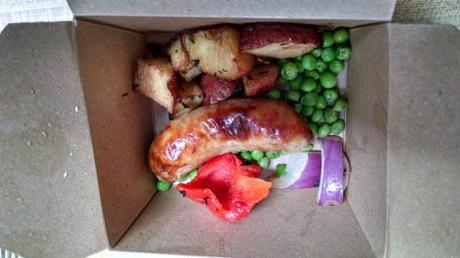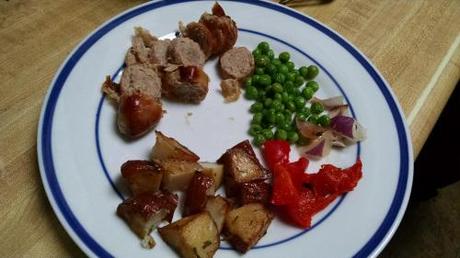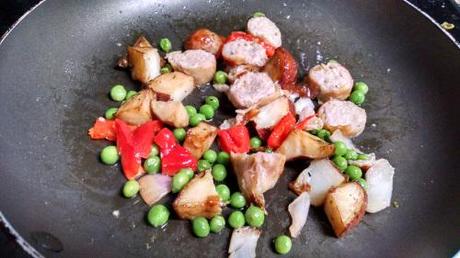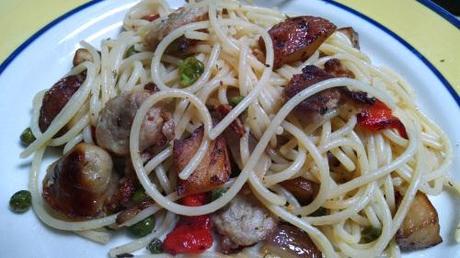Before you start this recipe there are a few things you should know:
Now that you will be saving tons of money each week, you can afford to buy better quality food. Organic spaghetti at Whole Foods costs $1.49/box. Each box contains 8 servings. That’s about 19 Cents a serving. It’s worth it, get the good stuff.
While we are talking about serving sizes – a serving of pasta is one eighth of the box of dry pasta. Once cooked, this gives you about a cup full of pasta, more than enough for a serving. (Believe it or not, a serving of pasta is not an endless measurement.) Get some storage containers or large zip bags and when you open the box of pasta, divide it into half, then half, then half again. Put each eighth into a bag and you’ll have pre-measured, ready to cook servings at your fingertips.
Olive oil – there are good fats and there are bad fats. Olive oil is a good fat – fast food burgers have bad fat. Adding a splash of olive oil to your food is a way to get good fats into your diet. It helps to make food taste better and makes you feel more satiated (full.) As with all of the food you’ll be buying for now on, buy the best possible olive oil you can. You don’t use much of it at any time and the taste will be worth it.
Get some good dinner plates and have silverware at hand. You don’t need to have matching sets (you can get nice single plates at thrift stores), eating off of real plates makes a difference. (And don’t forget to get some napkins to keep on hand.)
Speaking of eating, sit down when you eat. Pay attention to your food and put your darn phone away until you’re finished with your meal.
Pots and pans – we’ll be adding to this list, but at the very least, you should have:
- Sauce pan (for sauces, soups, and pasta)
- Small fry pan
- Small strainer
- Cooking spoon and spatula
- Some small storage containers and bags
Pantry – again we’ll be adding to this, but include:
- Olive oil
- A “combination” salt or seasoning (like Crazy salt or Parmesan, garlic salt)
Once you open a box of pasta, put it on your shopping list to buy another – if you have pasta in the house, you will always be able to make a meal.
Lastly, you never know what you are going to find at the hot food bars. Learn the techniques of how to combine foods and flavors and soon, you’ll be able to come up with your own ideas for meals.
English Breakfast Pasta
Based on a traditional English breakfast (sausage, potatoes, and peas) this dish can be served for either lunch or dinner. From start to finish it takes about 20 minutes. If need be, you can even make the dish the night before, put it in a storage container and heat it in the microwave at work the next day.
(Cost of *prepared* food from Whole Foods – $2.34)
Ingredients:
- 1 serving of dry pasta
From hot food bar:
- 1 breakfast sausage
- A few hash brown potatoes
- 2 Tablespoons of peas
- few slices of roasted onion
- 1 piece of roasted red pepper
- Olive oil
Instructions:
- At Whole Foods (or another store that has a pre-made food bar in it) gather your ingredients:

Price for this food was $2.34 at Whole Foods.
(By the way, that sausage is a serving of meat. You don’t need to eat a ton of meat, instead it’ more important that you eat a variety of good, nutritious food.)
- Place a small pan of water (filled about halfway) on the stove and heat it on High.
- While the water is heating, chop up the sausage and vegetables into smaller pieces. (This will ensure that you get something in every bite.)

- Place the meat/vegetable mixture in a fry pan, add a splash of olive oil and cook on medium. Occasionally stir. This mixture is already cooked, you just want to heat it up and meld the flavors a bit.

- Only when the water is boiling, add the serving of pasta. Stir occasionally until well cooked (approximately 15 minutes and no, you don’t need to throw the pasta against the wall, if it’s truly limp when you pull it out on a fork, it’s done.)
Warning – DO NOT LEAVE THE KITCHEN when you are cooking pasta. Murphy’s law, the water will *always* boil over when you are not there.
- Drain the pasta and add it to the pan with the meat/vegetables. Mix until the pasta is coated with oils.
- Add a few shakes of a seasoning salt (go easy, you want to enhance with the salt, not dominate.)
- Serve on a plate and enjoy.

What’s that? You’ve invited a friend to dinner? Just double everything (except the time to prepare) and divide between two plates.
Note: If you add the pasta when the water is cold and *then* heat, you will end up with a pot of glue. Go ahead, ask me how I know. Wait until you see boiling bubbles and only then add the pasta.
In our house, we know the pasta is near done when it starts “dancing” in the water. In the middle of the pan, you will begin to see pasta rise from the center and then move to the outsides with the hot water currents –it’s a dance of near completeness.
Tomorrow: A vegetarian pasta dish (and yes, you’ll love it.)
***
Wendy Thomas writes about the lessons learned while raising children and chickens in New Hampshire. Contact her at [email protected]
Also, join me on Facebook to find out more about the flock (children and chickens) and see some pretty funny chicken jokes, photos of tiny houses, and even a recipe or two.
Like what you read here? Consider subscribing to this blog so that you’ll never miss a post. And feel free to share with those who may need a little chicken love.

